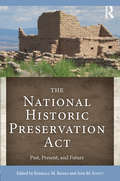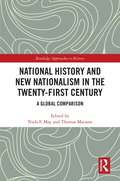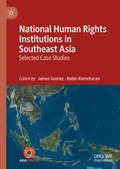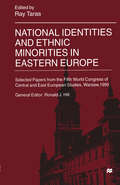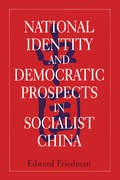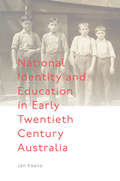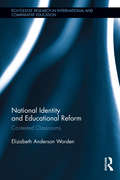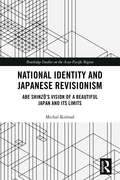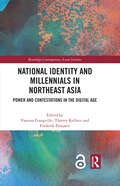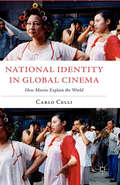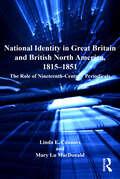- Table View
- List View
The National Historic Preservation Act: Past, Present, and Future
by Kimball M. Banks Ann M. ScottAssessing fifty years of the National Historic Preservation Act (NHPA), passed in 1966, this volume examines the impact of this key piece of legislation on heritage practices in the United States. The editors and contributing authors summarize how we approached compliance in the past, how we approach it now, and how we may approach it in the future. This volume presents how federal, state, tribal entities, and contractors in different regions address compliance issues; examines half a century of changes in the level of inventory, evaluation and mitigation practices, and determinations of eligibility; describes how the federal and state agencies have changed their approach over half a century; the Act is examined from the Federal, SHPO, THPO, Advisory Council, and regional perspectives. Using case studies authored by well-known heritage professionals based in universities, private practice, tribes, and government, this volume provides a critical and constructive examination of the NHPA and its future prospects. Archaeology students and scholars, as well heritage professionals, should find this book of interest.
National History and New Nationalism in the Twenty-First Century: A Global Comparison (Routledge Approaches to History #44)
by Niels F. May Thomas MaissenNational history has once again become a battlefield. In internal political conflicts, which are fought on the terrain of popular culture, museums, schoolbooks, and memorial politics, it has taken on a newly important and contested role. Irrespective of national specifics, the narratives of new nationalism are quite similar everywhere. National history is said to stretch back many centuries, expressesing the historical continuity of a homogeneous people and its timeless character. This people struggles for independence, guided by towering leaders and inspired by the sacrifice of martyrs. Unlike earlier forms of nationalism, the main enemies are no longer neighbouring states, but international and supranational institutions. To use national history as an integrative tool, new nationalists claim that the media and school history curricula should not contest or question the nation and its great historical deeds, as doubts threaten to weaken and dishonour the nation. This book offers a broad international overview of the rhetoric, contents, and contexts of the rise of these renewed national historical narratives, and of how professional historians have reacted to these phenomena. The contributions focus on a wide range of representative nations from around all over the globe.
National History and New Nationalism in the Twenty-First Century: A Global Comparison (Routledge Approaches to History #44)
by Niels F. May Thomas MaissenNational history has once again become a battlefield. In internal political conflicts, which are fought on the terrain of popular culture, museums, schoolbooks, and memorial politics, it has taken on a newly important and contested role. Irrespective of national specifics, the narratives of new nationalism are quite similar everywhere. National history is said to stretch back many centuries, expressesing the historical continuity of a homogeneous people and its timeless character. This people struggles for independence, guided by towering leaders and inspired by the sacrifice of martyrs. Unlike earlier forms of nationalism, the main enemies are no longer neighbouring states, but international and supranational institutions. To use national history as an integrative tool, new nationalists claim that the media and school history curricula should not contest or question the nation and its great historical deeds, as doubts threaten to weaken and dishonour the nation. This book offers a broad international overview of the rhetoric, contents, and contexts of the rise of these renewed national historical narratives, and of how professional historians have reacted to these phenomena. The contributions focus on a wide range of representative nations from around all over the globe.
National Human Rights Institutions in Southeast Asia: Selected Case Studies
by Robin Ramcharan James GomezThis book reviews Southeast Asia’s National Human Rights Institutions (NHRIs) as part of an emerging assessment of a nascent regional human rights architecture that is facing significant challenges in protecting human rights. The book asks, can NHRIs overcome its weaknesses and provide protection, including remedies, to victims of human rights abuses? Assessing NHRIs’ capacity to do so is vital as the future of human rights protection lies at the national level, and other parts of the architecture—the ASEAN Intergovernmental Commission on Human Rights (AICHR), and the international mechanism of the Universal Periodic Review (UPR)—though helpful, also have their limitations. The critical question the book addresses is whether NHRIs individually or collaboratively provide protection of fundamental human rights. The body of work offered in this book showcases the progress of the NHRIs in Southeast Asia where they also act as a barometer for the fluid political climate of their respective countries. Specifically, the book examines the NHRIs’ capacity to provide protection, notably through the pursuit of quasi-judicial functions, and concludes that this function has either been eroded due to political developments post-establishment or has not been included in the first place. The book’s findings point to the need for NHRIs to increase their effectiveness in the protection of human rights and invites readers and stakeholders to find ways of addressing this gap.
National Identities and Ethnic Minorities in Eastern Europe: Selected Papers from the Fifth World Congress of Central and East European Studies, Warsaw, 1995 (International Council for Central and East European Studies)
by Ray TarasThis volume provides a cross-national analysis of the changing identities of various national and ethnic groups, their new political influence in the emergent democracies and their efforts to revive suppressed cultures. It begins with a theoretical analysis of the concepts of national identity and ethnicity. It features case studies of contemporary Belarussian, Polish and Ukrainian national identities before turning to a study of Eastern Europe's hidden ethnic minorities, like the Finno-Ugric peoples in Russia, the Lemkos in Poland and the Gypsies in Bulgaria.
National Identities and Travel in Victorian Britain (Studies in Modern History)
by M. MorganThis book explores components of national identity in Victorian Britain by analyzing travel literature. It draws on published and unpublished travel journals by middle-class men and women from England, Scotland, and Wales who toured the Continent and/or Britain. The main aim is to illustrate both the contexts that inspired the various collective identities of Britishness, Englishness, Scotsness, and Welshness, as well as the qualities Victorian men and women had in mind when they used such terms to identify and imagine themselves collectively.
National Identities in Soviet Historiography: The Rise of Nations under Stalin (Central Asia Research Forum)
by Harun YilmazUnder Stalin’s totalitarian leadership of the USSR, Soviet national identities with historical narratives were constructed. These constructions envisaged how nationalities should see their imaginary common past, and millions of people defined themselves according to them. This book explains how and by whom these national histories were constructed and focuses on the crucial episode in the construction of national identities of Ukraine, Azerbaijan and Kazakhstan from 1936 and 1945. A unique comparative study of three different case studies, this book reveals different aims and methods of nation construction, despite the existence of one-party rule and a single overarching official ideology. The study is based on work in the often overlooked archives in the Ukraine, Azerbaijan, and Kazakhstan. By looking at different examples within the Soviet context, the author contributes to and often challenges current scholarship on Soviet nationality policies and Stalinist nation-building projects. He also brings a new viewpoint to the debate on whether the Soviet period was a project of developmentalist modernization or merely a renewed ‘Russian empire’. The book concludes that the local agents in the countries concerned had a sincere belief in socialism—especially as a project of modernism and development—and, at the same time, were strongly attached to their national identities. Claiming that local communist party officials and historians played a leading role in the construction of national narratives, this book will be of interest to historians and political scientists interested in the history of the Soviet Union and contemporary Eastern Europe, the Caucasus and Central Asia.
National Identities in Soviet Historiography: The Rise of Nations under Stalin (Central Asia Research Forum)
by Harun YilmazUnder Stalin’s totalitarian leadership of the USSR, Soviet national identities with historical narratives were constructed. These constructions envisaged how nationalities should see their imaginary common past, and millions of people defined themselves according to them. This book explains how and by whom these national histories were constructed and focuses on the crucial episode in the construction of national identities of Ukraine, Azerbaijan and Kazakhstan from 1936 and 1945. A unique comparative study of three different case studies, this book reveals different aims and methods of nation construction, despite the existence of one-party rule and a single overarching official ideology. The study is based on work in the often overlooked archives in the Ukraine, Azerbaijan, and Kazakhstan. By looking at different examples within the Soviet context, the author contributes to and often challenges current scholarship on Soviet nationality policies and Stalinist nation-building projects. He also brings a new viewpoint to the debate on whether the Soviet period was a project of developmentalist modernization or merely a renewed ‘Russian empire’. The book concludes that the local agents in the countries concerned had a sincere belief in socialism—especially as a project of modernism and development—and, at the same time, were strongly attached to their national identities. Claiming that local communist party officials and historians played a leading role in the construction of national narratives, this book will be of interest to historians and political scientists interested in the history of the Soviet Union and contemporary Eastern Europe, the Caucasus and Central Asia.
National Identity and Democratic Prospects in Socialist China
by Edward FriedmanThis analysis of every facet of a national identity makes it less likely that the next great explosion in the Commmunist world - and its consequences - will come as a surprise. It investigates tendencies in China that might lead it down the same path as Russia and Yugoslavia.
National Identity and Democratic Prospects in Socialist China
by Edward FriedmanThis analysis of every facet of a national identity makes it less likely that the next great explosion in the Commmunist world - and its consequences - will come as a surprise. It investigates tendencies in China that might lead it down the same path as Russia and Yugoslavia.
National Identity and Education in Early Twentieth Century Australia
by Jan KeaneThis fascinating book explores how curriculum content in education was used to cultivate a sense of Australian national identity during the first two decades of the twentieth century. Providing a comprehensive picture of the entire reading curriculum in Victorian government schools over a period of almost two decades, the author demonstrates that, contrary to received wisdom, the Department of Education made every effort to integrate children of different backgrounds. Using three dimensions frequently cited in national identity theory – landscape, history, and mythology – readers are shown how material was chosen specifically to engage young white settler children and to help them overcome their sense of Australia as the ‘other’. National Identity and Education in Early Twentieth Century Australia not only brings about a clearer understanding of how Australia came to be ‘Australian’ in character, it establishes how curriculum content may be brought into the service of nation-building across the globe.
National Identity and Education in Early Twentieth Century Australia
by Jan KeaneThis fascinating book explores how curriculum content in education was used to cultivate a sense of Australian national identity during the first two decades of the twentieth century. Providing a comprehensive picture of the entire reading curriculum in Victorian government schools over a period of almost two decades, the author demonstrates that, contrary to received wisdom, the Department of Education made every effort to integrate children of different backgrounds. Using three dimensions frequently cited in national identity theory – landscape, history, and mythology – readers are shown how material was chosen specifically to engage young white settler children and to help them overcome their sense of Australia as the ‘other’. National Identity and Education in Early Twentieth Century Australia not only brings about a clearer understanding of how Australia came to be ‘Australian’ in character, it establishes how curriculum content may be brought into the service of nation-building across the globe.
National Identity and Educational Reform: Contested Classrooms (Routledge Research in International and Comparative Education)
by Elizabeth Anderson WordenNational identity in Moldova remains contested despite repeated attempts by governments, historians, and educators to cultivate a shared sense of national belonging through the development of history textbooks. Concern over professional status and distrust of the government’s motivations halted these reforms, demonstrating that the success of such efforts greatly depends on teachers’ and citizens’ social memory and everyday lives. This volume looks at educational reform and the struggle over national identity in the history classroom from the perspectives of five different groups: elected politicians, Ministry of Education officials, textbook authors and historians, teachers, and students. Each chapter explores the actors’ motivations and agendas regarding reform, their role in promoting or obstructing the reform process, and their opinions about the ensuing controversy. Drawing on months of fieldwork and original research, author Elizabeth Worden examines the importance of teachers and students in the success or failure of a reform initiative.
National Identity and Educational Reform: Contested Classrooms (Routledge Research in International and Comparative Education)
by Elizabeth Anderson WordenNational identity in Moldova remains contested despite repeated attempts by governments, historians, and educators to cultivate a shared sense of national belonging through the development of history textbooks. Concern over professional status and distrust of the government’s motivations halted these reforms, demonstrating that the success of such efforts greatly depends on teachers’ and citizens’ social memory and everyday lives. This volume looks at educational reform and the struggle over national identity in the history classroom from the perspectives of five different groups: elected politicians, Ministry of Education officials, textbook authors and historians, teachers, and students. Each chapter explores the actors’ motivations and agendas regarding reform, their role in promoting or obstructing the reform process, and their opinions about the ensuing controversy. Drawing on months of fieldwork and original research, author Elizabeth Worden examines the importance of teachers and students in the success or failure of a reform initiative.
National Identity and Geopolitical Visions: Maps of Pride and Pain
by Gertjan DijinkFrom the Third Reich to Bosnia, nationalism - a sense of a nation's place in the world - has been responsible for much bloodshed. Nationalism may be manipulated by political leaders or governments but it springs from the people. Something in the history and environment of a national group creates it. This volume aims to locate and analyze the myth of national identity and its value in creating pride, deflecting fear or legitimating aggression. A range of essays - on Britain, the United States, Germany, Russia, Iraq, Serbia, Argentina, Australia, and India - illustrate the different manifestations of the geographical imagination across the countries of the world.
National Identity and Geopolitical Visions: Maps of Pride and Pain
by Gertjan DijinkFrom the Third Reich to Bosnia, nationalism - a sense of a nation's place in the world - has been responsible for much bloodshed. Nationalism may be manipulated by political leaders or governments but it springs from the people. Something in the history and environment of a national group creates it. This volume aims to locate and analyze the myth of national identity and its value in creating pride, deflecting fear or legitimating aggression. A range of essays - on Britain, the United States, Germany, Russia, Iraq, Serbia, Argentina, Australia, and India - illustrate the different manifestations of the geographical imagination across the countries of the world.
National Identity and Japanese Revisionism: Abe Shinzo’s vision of a beautiful Japan and its limits (Routledge Studies on the Asia-Pacific Region)
by Michal KolmasOver the course of the twentieth century, Japan has experienced a radical shift in its self-perception. After World War II, Japan embraced a peaceful and anti-militarist identity, which was based on its war-prohibiting Constitution and the foreign policy of the Yoshida doctrine. For most of the twentieth century, this identity was unusually stable. In the last couple of decades, however, Japan’s self-perception and foreign policy seem to have changed. Tokyo has conducted a number of foreign policy actions as well as symbolic internal gestures that would have been unthinkable a few decades ago and that symbolize a new and more confident Japan. Japanese politicians – including Prime Minister Abe Shinzō – have adopted a new discourse depicting pacifism as a hindrance, rather than asset, to Japan’s foreign policy. Does that mean that “Japan is back”?In order to better understand the dynamics of contemporary Japan, Kolmaš joins up the dots between national identity theory and Japanese revisionism. The book shows that while political elites and a portion of the Japanese public call for re-articulation of Japan’s peaceful identity, there are still societal and institutional forces that prevent this change from entirely materializing.
National Identity and Japanese Revisionism: Abe Shinzo’s vision of a beautiful Japan and its limits (Routledge Studies on the Asia-Pacific Region)
by Michal KolmasOver the course of the twentieth century, Japan has experienced a radical shift in its self-perception. After World War II, Japan embraced a peaceful and anti-militarist identity, which was based on its war-prohibiting Constitution and the foreign policy of the Yoshida doctrine. For most of the twentieth century, this identity was unusually stable. In the last couple of decades, however, Japan’s self-perception and foreign policy seem to have changed. Tokyo has conducted a number of foreign policy actions as well as symbolic internal gestures that would have been unthinkable a few decades ago and that symbolize a new and more confident Japan. Japanese politicians – including Prime Minister Abe Shinzō – have adopted a new discourse depicting pacifism as a hindrance, rather than asset, to Japan’s foreign policy. Does that mean that “Japan is back”?In order to better understand the dynamics of contemporary Japan, Kolmaš joins up the dots between national identity theory and Japanese revisionism. The book shows that while political elites and a portion of the Japanese public call for re-articulation of Japan’s peaceful identity, there are still societal and institutional forces that prevent this change from entirely materializing.
National Identity and Millennials in Northeast Asia: Power and Contestations in the Digital Age (Routledge Contemporary Asian Societies)
by Vanessa Frangville Thierry Kellner Frederik PonjaertThis book examines how the young in Northeast Asia engage with the political, especially in terms of the production, reformulation, or contestation of their national identities. Through case studies covering China, Japan, South Korea, North Korea and Taiwan, the contributions provide a study of the online spaces where youth engage with current debates regarding national identities. The book also unpacks the distinctive forms of expression and negotiation of national identities favoured by younger generations across Northeast Asia and asks questions specifically raised by their political mobilisation. For example, how their public mobilisation for a given cause has forced them to rethink their place in national and global communities. This book will be a valuable resource for scholars and students of East Asian culture and politics, media studies and youth studies. The Introduction of this book is freely available as a downloadable Open Access PDF at http://www.taylorfrancis.com under a Creative Commons Attribution-Non Commercial-No Derivatives (CC-BY-NC-ND) 4.0 license.
National Identity and Millennials in Northeast Asia: Power and Contestations in the Digital Age (Routledge Contemporary Asian Societies)
by Vanessa Frangville Thierry Kellner Frederik PonjaertThis book examines how the young in Northeast Asia engage with the political, especially in terms of the production, reformulation, or contestation of their national identities. Through case studies covering China, Japan, South Korea, North Korea and Taiwan, the contributions provide a study of the online spaces where youth engage with current debates regarding national identities. The book also unpacks the distinctive forms of expression and negotiation of national identities favoured by younger generations across Northeast Asia and asks questions specifically raised by their political mobilisation. For example, how their public mobilisation for a given cause has forced them to rethink their place in national and global communities. This book will be a valuable resource for scholars and students of East Asian culture and politics, media studies and youth studies. The Introduction of this book is freely available as a downloadable Open Access PDF at http://www.taylorfrancis.com under a Creative Commons Attribution-Non Commercial-No Derivatives (CC-BY-NC-ND) 4.0 license.
National Identity in 21st-Century Cuban Cinema: Screening the Repeating Island
by Dunja FehimovićNational Identity in 21st-Century Cuban Cinema tours early 21st-century Cuban cinema through four key figures—the monster, the child, the historic icon, and the recluse—in order to offer a new perspective on the relationship between the Revolution, culture, and national identity in contemporary Cuba. Exploring films chosen to convey a recent diversification of subject matters, genres, and approaches, it depicts a changing industrial landscape in which the national film institute (ICAIC) coexists with international co-producers and small, ‘independent’ production companies. By tracing the reappearance, reconfiguration, and recycling of national identity in recent fiction feature films, the book demonstrates that the spectre of the national haunts Cuban cinema in ways that reflect intensified transnational flows of people, capital, and culture. Moreover, it shows that the creative manifestations of this spectre screen—both hiding and revealing—a persistent anxiety around Cubanness even as national identity is transformed by connections to the outside world.
National Identity in 21st-Century Cuban Cinema: Screening the Repeating Island
by Dunja FehimovićNational Identity in 21st-Century Cuban Cinema tours early 21st-century Cuban cinema through four key figures—the monster, the child, the historic icon, and the recluse—in order to offer a new perspective on the relationship between the Revolution, culture, and national identity in contemporary Cuba. Exploring films chosen to convey a recent diversification of subject matters, genres, and approaches, it depicts a changing industrial landscape in which the national film institute (ICAIC) coexists with international co-producers and small, ‘independent’ production companies. By tracing the reappearance, reconfiguration, and recycling of national identity in recent fiction feature films, the book demonstrates that the spectre of the national haunts Cuban cinema in ways that reflect intensified transnational flows of people, capital, and culture. Moreover, it shows that the creative manifestations of this spectre screen—both hiding and revealing—a persistent anxiety around Cubanness even as national identity is transformed by connections to the outside world.
National Identity in Global Cinema: How Movies Explain the World
by C. CelliWhen themes of historical and cultural identity appear and repeat in popular film, it is possible to see the real pulse of a nation and comprehend a people, their culture and their history. National Identity in Global Cinema describes how national cultures as reflected in popular cinema can truly explain the world, one country at a time.
National Identity in Great Britain and British North America, 1815-1851: The Role of Nineteenth-Century Periodicals
by Linda E. Connors Mary Lu MacDonaldExamining the complex and rapidly expanding world of print culture and reading in the nineteenth century, Linda E. Connors and Mary Lu MacDonald show how periodicals in the United Kingdom and British North America shaped and promoted ideals about national identity. In the wake of the Napoleonic wars, periodicals instilled in readers an awareness of cultures, places and ways of living outside their own experience, while also proffering messages about what it meant to be British. The authors cast a wide net, showing the importance of periodicals for understanding political and economic life, faith and religion, the world of women and children, the idea of progress as a transcendent ideology, and the relationships between the parts (for example, Scotland or Nova Scotia) and the whole (Great Britain). Analyzing the British identity of expatriate nineteenth-century Britons in North America alongside their counterparts in Great Britain enables insights into whether residents were encouraged to identify themselves by country of residence, by country of birth, or by their newly acquired understanding of a broader whole. Enhanced by a succinct and informative catalogue of data, including editorship and price, about the periodicals analyzed, this study provides a striking history of the era and brings clarity to the perception of British transcendence and progress that emerged with such force and appeal after 1815.
National Identity in Great Britain and British North America, 1815-1851: The Role of Nineteenth-Century Periodicals
by Linda E. Connors Mary Lu MacDonaldExamining the complex and rapidly expanding world of print culture and reading in the nineteenth century, Linda E. Connors and Mary Lu MacDonald show how periodicals in the United Kingdom and British North America shaped and promoted ideals about national identity. In the wake of the Napoleonic wars, periodicals instilled in readers an awareness of cultures, places and ways of living outside their own experience, while also proffering messages about what it meant to be British. The authors cast a wide net, showing the importance of periodicals for understanding political and economic life, faith and religion, the world of women and children, the idea of progress as a transcendent ideology, and the relationships between the parts (for example, Scotland or Nova Scotia) and the whole (Great Britain). Analyzing the British identity of expatriate nineteenth-century Britons in North America alongside their counterparts in Great Britain enables insights into whether residents were encouraged to identify themselves by country of residence, by country of birth, or by their newly acquired understanding of a broader whole. Enhanced by a succinct and informative catalogue of data, including editorship and price, about the periodicals analyzed, this study provides a striking history of the era and brings clarity to the perception of British transcendence and progress that emerged with such force and appeal after 1815.
